A Remote Sensing Approach for Biomass Assessment in Winter Wheat Using the NDVI Second Derivative in Terms of NIR
Abstract
1. Introduction
2. Materials and Methods
2.1. Study Area
2.2. UAV Flight Planning and Data Collection
2.3. Crop Evaluation
2.4. Data Analysis
Uncertainty and Comparative Advantages of Vegetation Indices
2.5. Processing of Results
2.6. Mathematical Modeling
3. Results and Discussion
3.1. Results Obtained from Field Research
3.2. Analysis of the Data Obtained
3.3. Comparative Analysis of Vegetation Indices
4. Conclusions
Author Contributions
Funding
Institutional Review Board Statement
Data Availability Statement
Acknowledgments
Conflicts of Interest
Abbreviations
| NDVI | Normalized difference vegetation index |
| NDVI″ | Second derivative of NDVI in terms of NIR |
| NDWI | Normalized difference water index |
| NIR | Near-infrared |
| RGN | Red + Green + Near Infrared |
| RGB | Red + Green + Blue |
| HFOV | Horizontal field of view |
References
- Yang, L.; He, X.; Shen, F.; Zhou, C.; Zhu, A.X.; Gao, B.; Chen, Z.; Li, M. Improving prediction of soil organic carbon content in croplands using phenological parameters extracted from NDVI time series data. Soil Tillage Res. 2020, 196, 104465. [Google Scholar] [CrossRef]
- Wang, H.; Magagi, R.; Goïta, K.; Trudel, M.; McNairn, H.; Powers, J. Crop phenology retrieval via polarimetric SAR decomposition and Random Forest algorithm. Remote Sens. Environ. 2019, 231, 111234. [Google Scholar] [CrossRef]
- Anwar, M.R.; Liu, D.L.; Farquharson, R.; Macadam, I.; Abadi, A.; Finlayson, J.; Wang, B.; Ramilan, T. Climate change impacts on phenology and yields of five broadacre crops at four climatologically distinct locations in Australia. Agric. Syst. 2015, 132, 133–144. [Google Scholar] [CrossRef]
- FAO Handbook on Crop Statistics: Improving Methods for Measuring Crop Area, Production and Yield; Pasetto, L., Ed.; FAO Statistics Division (ESS): Rome, Italy, 2018. [Google Scholar]
- Biazin, B.; Wondatir, S.; Tilahun, G.; Asaro, N.; Amede, T. Using AquaCrop as a Decision-Support Tool for Small-Scale Irrigation Systems Was Dictated by the Institutional and Market Incentives in Ethiopia. Front. Water 2021, 3, 96. [Google Scholar] [CrossRef]
- Lorite, I.J.; García-Vila, M.; Santos, C.; Ruiz-Ramos, M.; Fereres, E. AquaData and AquaGIS: Two Computer Utilities for Temporal and Spatial Simulations of Water-Limited Yield with AquaCrop. Comput. Electron. Agric. 2013, 96, 227–237. [Google Scholar] [CrossRef]
- Han, C.; Zhang, B.; Chen, H.; Wei, Z.; Liu, Y. Spatially Distributed Crop Model Based on Remote Sensing. Agric. Water Manag. 2019, 218, 165–173. [Google Scholar] [CrossRef]
- Liu, L.; Zhang, X.; Yu, Y.; Gao, F.; Yang, Z. Real-Time Monitoring of Crop Phenology in the Midwestern United States Using VIIRS Observations. Remote Sens. 2018, 10, 1540. [Google Scholar] [CrossRef]
- Tian, H.; Ren, W.; Tao, B.; Sun, G.; Chappelka, A.; Wang, X.; Pan, S.; Yang, J.; Liu, J.S.; Felzer, B.M.; et al. Climate extremes and ozone pollution: A growing threat to China’s food security. Ecosyst. Health Sustain. 2016, 2, e01203. [Google Scholar] [CrossRef]
- Cho, S.J.; McCarl, B.A. Climate change influences on crop mix shifts in the United States. Sci. Rep. 2017, 7, 40845. [Google Scholar] [CrossRef]
- Ortiz-Monasterio, J.I.; Lobell, D.B. Remote sensing assessment of regional yield losses due to sub-optimal planting dates and fallow period weed management. Field Crops Res. 2007, 101, 80–87. [Google Scholar] [CrossRef]
- De Castro, A.; Six, J.; Plant, R.; Peña, J. Mapping Crop Calendar Events and Phenology-Related Metrics at the Parcel Level by Object-Based Image Analysis (OBIA) of MODIS-NDVI Time-Series: A Case Study in Central California. Remote Sens. 2018, 10, 1745. [Google Scholar] [CrossRef]
- Kotsuki, S.; Tanaka, K. SACRA-A method for the estimation of global high-resolution crop calendars from a satellite-sensed NDVI. Hydrol. Earth Syst. Sci. 2015, 19, 4441–4461. [Google Scholar] [CrossRef]
- Pan, Y.; Nie, Y.; Watene, C.; Zhu, J.; Liu, F. Phenological Observations on Classical Prehistoric Sites in the Middle and Lower Reaches of the Yellow River Based on Landsat NDVI Time Series. Remote Sens. 2017, 9, 374. [Google Scholar] [CrossRef]
- Boschetti, M.; Stroppiana, D.; Brivio, P.A.; Bocchi, S. Multi-year monitoring of rice crop phenology through time series analysis of MODIS images. Int. J. Remote Sens. 2009, 30, 4643–4662. [Google Scholar] [CrossRef]
- Huang, X.; Liu, J.; Zhu, W.; Atzberger, C.; Liu, Q. The Optimal Threshold and Vegetation Index Time Series for Retrieving Crop Phenology Based on a Modified Dynamic Threshold Method. Remote Sens. 2019, 11, 2725. [Google Scholar] [CrossRef]
- Sakamoto, T.; Wardlow, B.D.; Gitelson, A.A.; Verma, S.B.; Suyker, A.E.; Arkebauer, T.J. A two-step filtering approach for detecting maize and soybean phenology with time-series MODIS data. Remote Sens. Environ. 2010, 114, 2146–2159. [Google Scholar] [CrossRef]
- Shammi, S.A.; Meng, Q. Use Time Series NDVI and EVI to Develop Dynamic Crop Growth Metrics for Yield Modeling. Ecol. Indic. 2021, 121, 107124. [Google Scholar] [CrossRef]
- Johnson, D.M.; Rosales, A.; Mueller, R.; Reynolds, C.; Frantz, R.; Anyamba, A.; Pak, E.; Tucker, C. USA Crop Yield Estim. MODIS NDVI: Are Remote. Sensed Models Better Than Simple Trend Anal. Remote Sens. 2021, 13, 4227. [Google Scholar] [CrossRef]
- Lischeid, G.; Webber, H.; Sommer, M.; Nendel, C.; Ewert, F. Machine Learning in Crop Yield Modelling: A Powerful Tool, but No Surrogate for Science. Agric. For. Meteorol. 2022, 312, 108698. [Google Scholar] [CrossRef]
- van Klompenburg, T.; Kassahun, A.; Catal, C. Crop Yield Prediction Using Machine Learning: A Systematic Literature Review. Comput. Electron. Agric. 2020, 177, 105709. [Google Scholar] [CrossRef]
- Hu, H.; Zhou, H.; Cao, K.; Lou, W.; Zhang, G.; Gu, Q.; Wang, J. Biomass Estimation of Milk Vetch Using UAV Hyperspectral Imagery and Machine Learning. Remote Sens. 2024, 16, 2183. [Google Scholar] [CrossRef]
- Vahidi, M.; Shafian, S.; Thomas, S.; Maguire, R. Pasture Biomass Estimation Using Ultra-High-Resolution RGB UAVs Images and Deep Learning. Remote Sens. 2023, 15, 5714. [Google Scholar] [CrossRef]
- Yang, Z.-Y.; Xia, W.-K.; Chu, H.-Q.; Su, W.-H.; Wang, R.-F.; Wang, H. A Comprehensive Review of Deep Learning Applications in Cotton Industry: From Field Monitoring to Smart Processing. Plants 2025, 14, 1481. [Google Scholar] [CrossRef] [PubMed]
- Rouse, J.W.; Haas, R.H.; Shell, J.A.; Deering, D.W.; Harlan, J.C. Monitoring the Vernal Advancement and Retrogradation (Green Wave Effect) of Natural Vegetation; Texas A & M University, Remote Sensing Center: College Station, TX, USA, 1974. [Google Scholar]
- Atanasov, A.I.; Atanasov, A.Z.; Evstatiev, B.I. Application of NDVI for Early Detection of Yellow Rust (Puccinia striiformis). AgriEngineering 2025, 7, 160. [Google Scholar] [CrossRef]
- Kyratzis, A.; Skarlatos, D.; Fotopoulos, V.; Vamvakousis, V.; Katsiotis, A. Investigating Correlation among NDVI Index Derived by Unmanned Aerial Vehicle Photography and Grain Yield under Late Drought Stress Conditions. Procedia Environ. Sci. 2015, 29, 225–226. [Google Scholar] [CrossRef][Green Version]
- Duan, B.; Fang, S.; Zhu, R.; Wu, X.; Wang, S.; Gong, Y.; Peng, Y. Remote Estimation of Rice Yield with Unmanned Aerial Vehicle (Uav) Data and Spectral Mixture Analysis. Front. Plant Sci. 2019, 10, 204. [Google Scholar] [CrossRef]
- Atanasov, A.I.; Mihova, G.M.; Atanasov, A.Z.; Vlăduț, V. Long-Term Assessment of NDVI Dynamics in Winter Wheat (Triticum aestivum) Using a Small Unmanned Aerial Vehicle. Agriculture 2025, 15, 394. [Google Scholar] [CrossRef]
- Hassan, M.A.; Yang, M.; Rasheed, A.; Yang, G.; Reynolds, M.; Xia, X.; Xiao, Y.; He, Z. A Rapid Monitoring of NDVI across the Wheat Growth Cycle for Grain Yield Prediction Using a Multi-Spectral UAV Platform. Plant Sci. 2019, 282, 95–103. [Google Scholar] [CrossRef]
- White, M.A.; Nemani, R.R. Real-Time Monitoring and Short-Term Forecasting of Land Surface Phenology. Remote Sens. Environ. 2006, 104, 43–49. [Google Scholar] [CrossRef]
- Atkinson, P.M.; Jeganathan, C.; Dash, J.; Atzberger, C. Inter-Comparison of Four Models for Smoothing Satellite Sensor Time-Series Data to Estimate Vegetation Phenology. Remote Sens. Environ. 2012, 123, 400–417. [Google Scholar] [CrossRef]
- Marti, J.; Bort, J.; Slafer, G.A.; Araus, J.L. Can Wheat Yield Be Assessed by Early Measurements of Normalized Difference Vegetation Index? Ann. Appl. Biol. 2007, 150, 253–257. [Google Scholar] [CrossRef]
- Seo, B.; Lee, J.; Lee, K.D.; Hong, S.; Kang, S. Improving Remotely-Sensed Crop Monitoring by NDVI-Based Crop Phenology Estimators for Corn and Soybeans in Iowa and Illinois, USA. Field Crops Res. 2019, 238, 113–128. [Google Scholar] [CrossRef]
- Misra, G.; Buras, A.; Menzel, A. Effects of Different Methods on the Comparison between Land Surface and Ground Phenology—A Methodological Case Study from South-Western Germany. Remote Sens. 2016, 8, 753. [Google Scholar] [CrossRef]
- Tan, B.; Morisette, J.T.; Wolfe, R.E.; Gao, F.; Ederer, G.A.; Nightingale, J.; Pedelty, J.A. An Enhanced TIMESAT Algorithm for Estimating Vegetation Phenology Metrics from MODIS Data. Remote Sens. 2011, 4, 361–371. [Google Scholar] [CrossRef]
- Yang, Y.; Tao, B.; Liang, L.; Huang, Y.; Matocha, C.; Lee, C.D.; Sama, M.; Masri, B.E.; Ren, W. Detecting Recent Crop Phenology Dynamics in Corn and Soybean Cropping Systems of Kentucky. Remote Sens. 2021, 13, 1615. [Google Scholar] [CrossRef]
- Sánchez, N.; Plaza, J.; Criado, M.; Pérez-Sánchez, R.; Gómez-Sánchez, M.Á.; Morales-Corts, M.R.; Palacios, C. The Second Derivative of the NDVI Time Series as an Estimator of Fresh Biomass: A Case Study of Eight Forage Associations Monitored via UAS. Drones 2023, 7, 347. [Google Scholar] [CrossRef]
- Liu, T.; Liu, X.; Liu, M.; Wu, L. Evaluating Heavy Metal Stress Levels in Rice Based on Remote Sensing Phenology. Sensors 2018, 18, 860. [Google Scholar] [CrossRef]
- Ghilardi, F.; De Petris, S.; Torti, V.; Giacoma, C.; Borgogno-Mondino, E. A possible role of NDVI time series from Landsat Mission to characterize lemurs habitats degradation in Madagascar. Sci. Total Environ. 2025, 974, 179243. [Google Scholar] [CrossRef]
- Lumbierres, M.; Méndez, P.F.; Bustamante, J.; Soriguer, R.; Santamaría, L. Modeling Biomass Production in Seasonal Wetlands Using MODIS NDVI Land Surface Phenology. Remote Sens. 2017, 9, 392. [Google Scholar] [CrossRef]
- Schucknecht, A.; Meroni, M.; Kayitakire, F.; Boureima, A. Phenology-Based Biomass Estimation to Support Rangeland Management in Semi-Arid Environments. Remote Sens. 2017, 9, 463. [Google Scholar] [CrossRef]
- Perry, E.; Sheffield, K.; Crawford, D.; Akpa, S.; Clancy, A.; Clark, R. Spatial and Temporal Biomass and Growth for Grain Crops Using NDVI Time Series. Remote Sens. 2022, 14, 3071. [Google Scholar] [CrossRef]
- DJI. 2025. Available online: https://www.dji.com/bg/mavic-2/info (accessed on 25 June 2025).
- Pix4Dcapture. 2025. Available online: https://www.pix4d.com/product/pix4dcapture/ (accessed on 25 June 2025).
- Mapir. 2025. Available online: https://www.mapir.camera/collections/survey3/products/survey3w-camera-red-green-nir-rgn-ndvi (accessed on 25 June 2025).
- Mapir. 2025. Available online: https://www.mapir.camera/en-gb/products/survey3-gps-receiver?srsltid=AfmBOoqfvv5La7_44iDyEXSN6rLrOeX0T_pT29XgFU01rYAn8PdA-Ikp (accessed on 25 June 2025).
- McFEETERS, S.K. The Use of the Normalized Difference Water Index (NDWI) in the Delineation of Open Water Features. Int. J. Remote Sens. 1996, 17, 1425–1432. [Google Scholar] [CrossRef]
- Pix4Dfields. 2025. Available online: https://www.pix4d.com/product/pix4dfields/ (accessed on 25 June 2025).
- Dimitrov, S.D. Example application of a simple linear regression and correlation in transportation studies using MS Excel. Mech. Transp. Commun. 2010, 2, BG-3.9–BG-3.16. (In Bulgarian) [Google Scholar]
- Microsoft, 2025. Available online: https://www.microsoft.com/en-us/microsoft-365 (accessed on 25 June 2025).



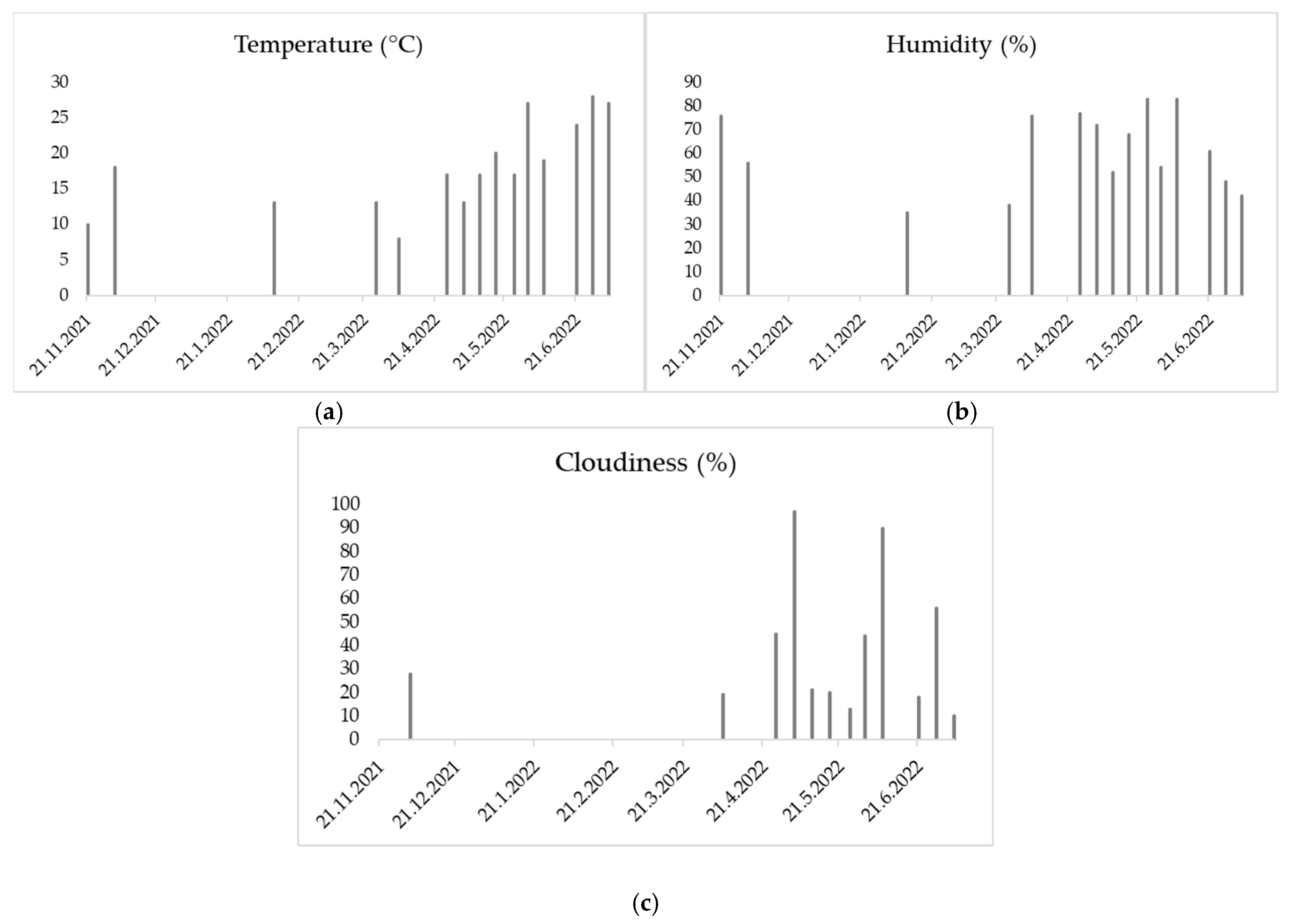
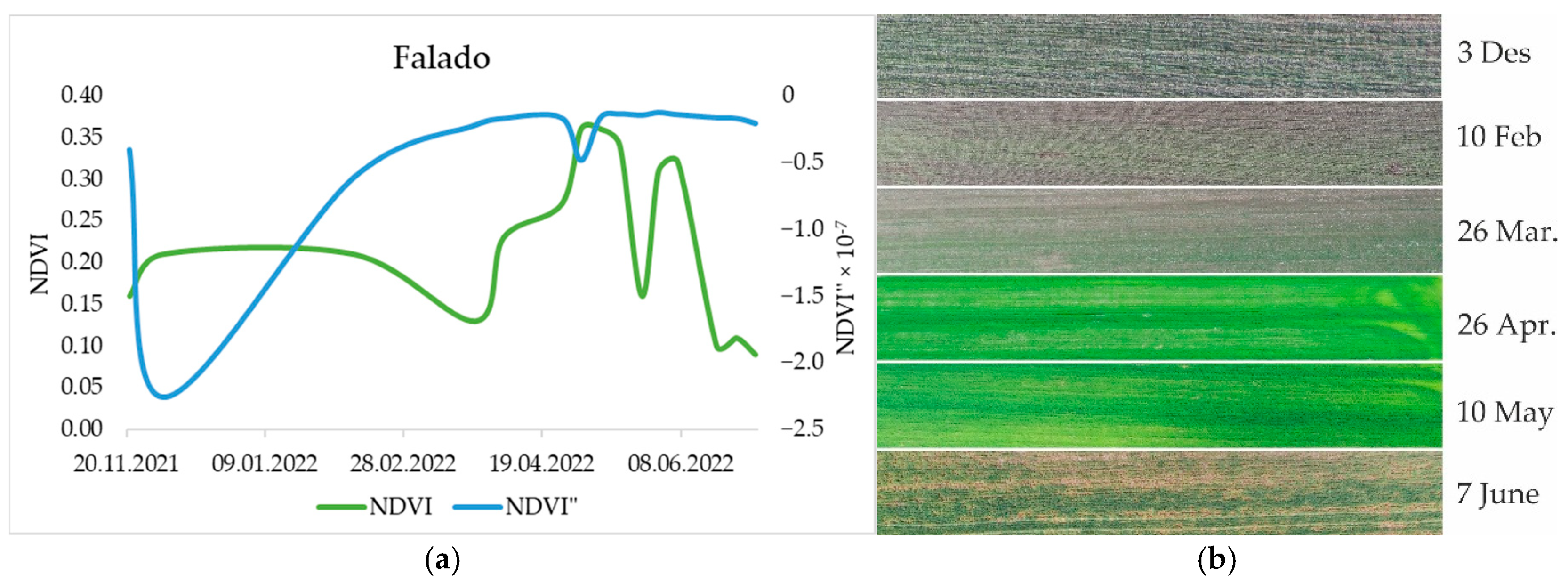



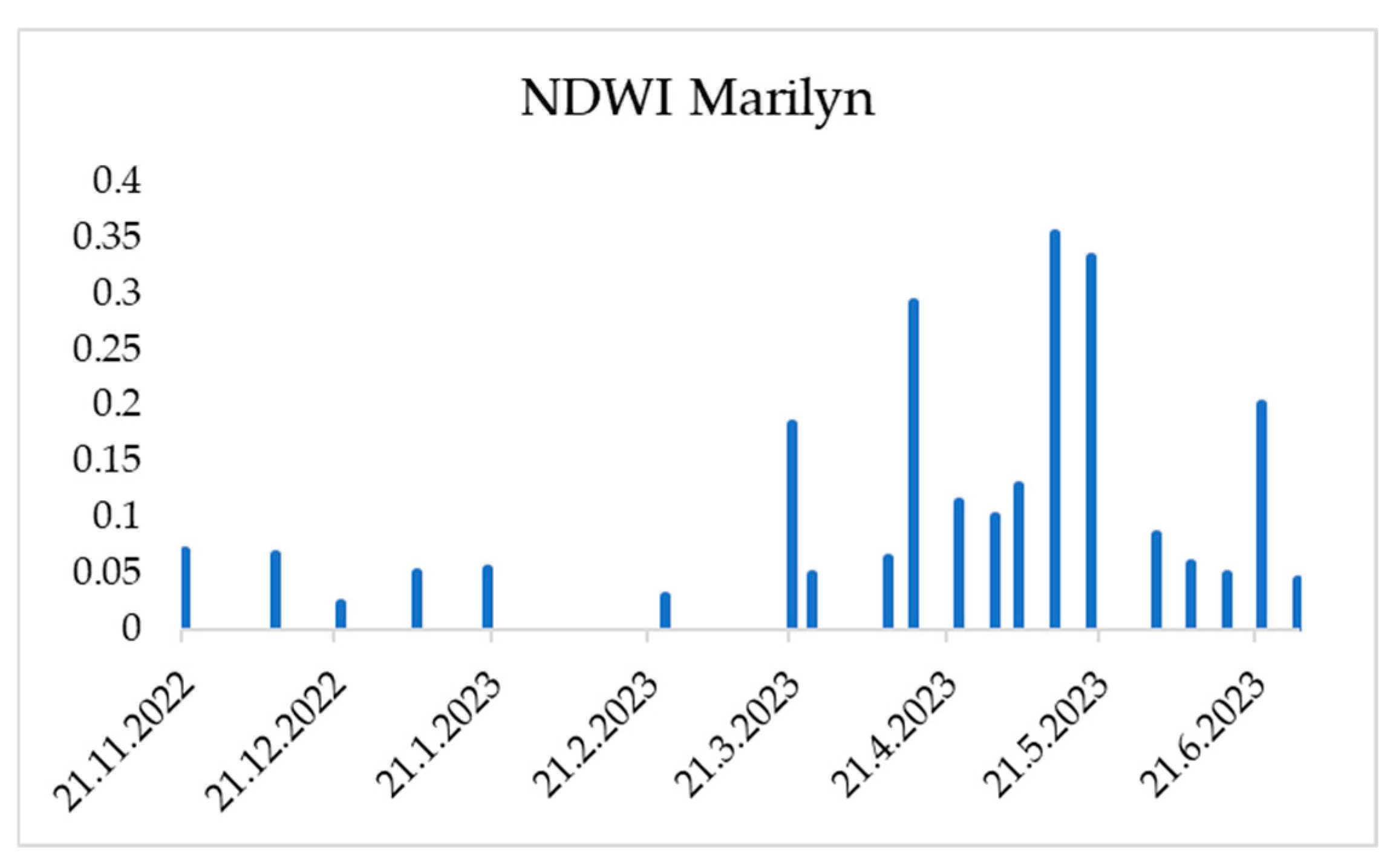
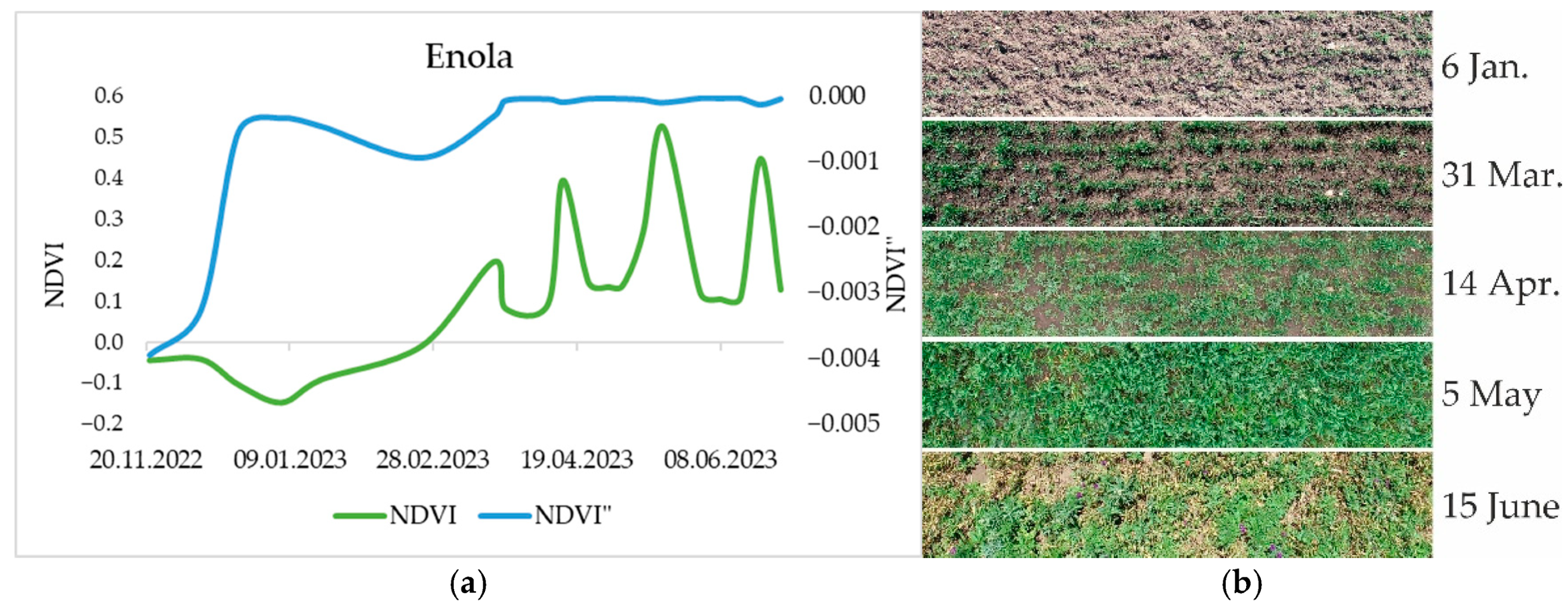


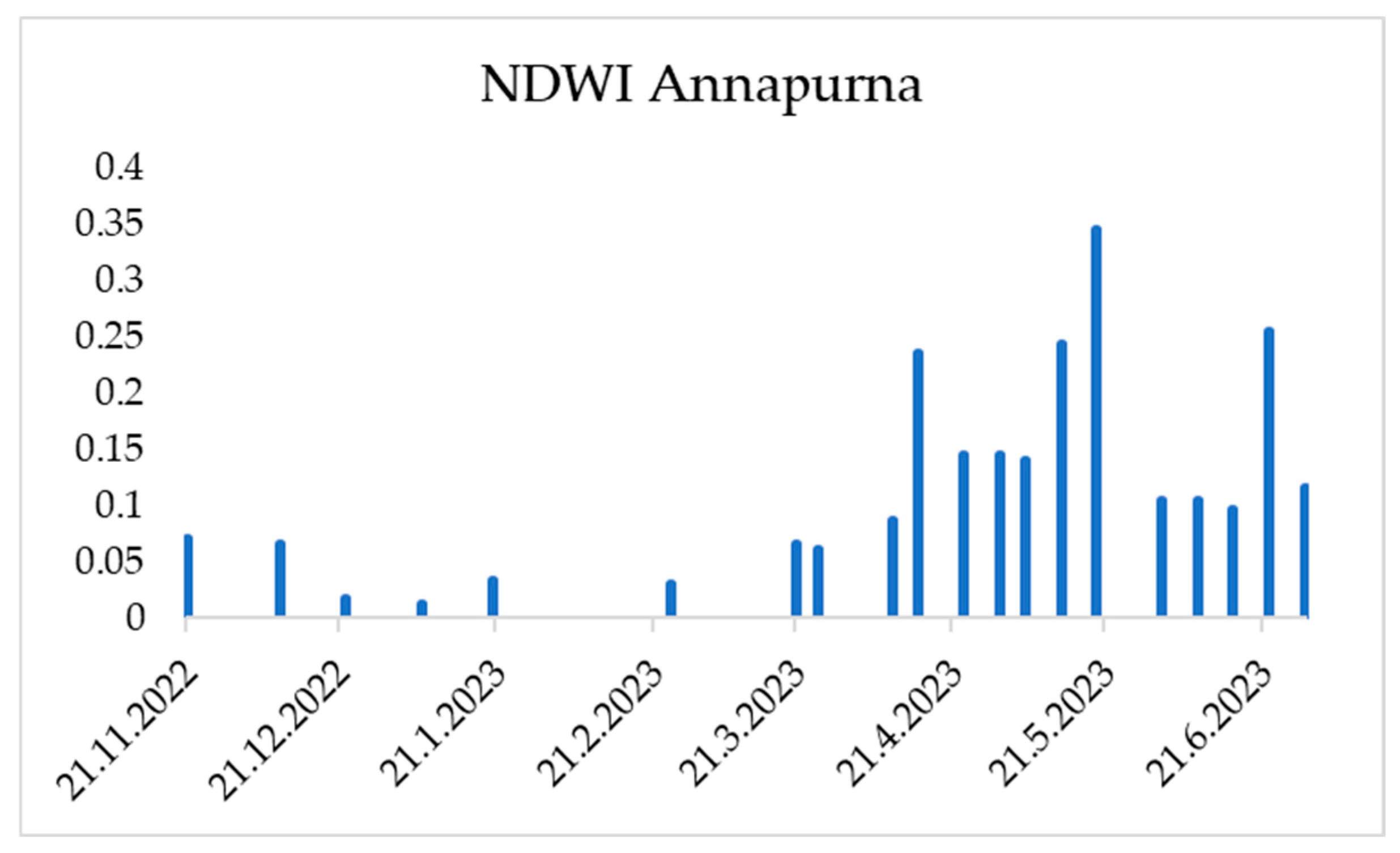

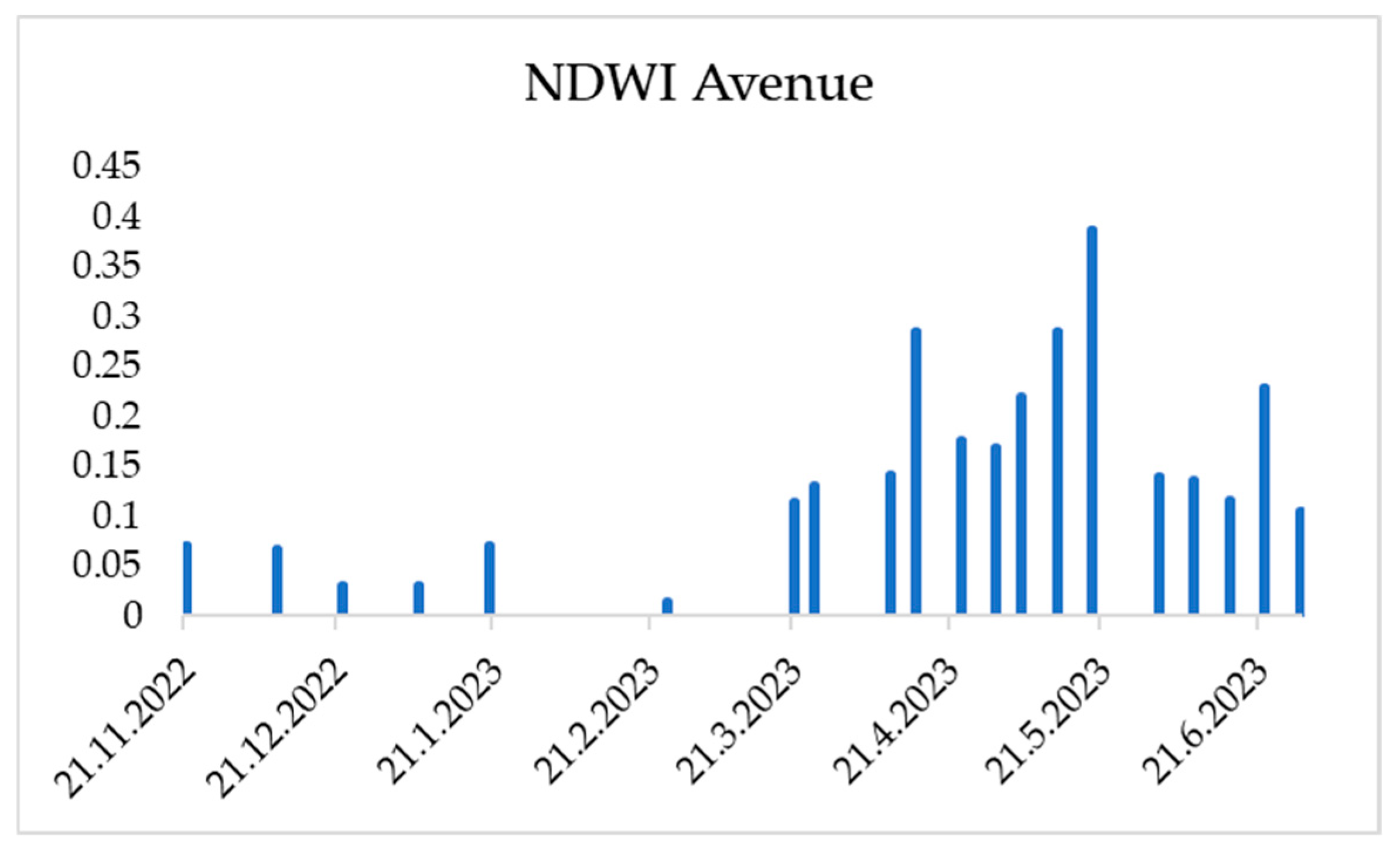


| Data | 21 Nov 2021 | 3 Dec 2021 | 10 Feb 2022 | 26 Mar 2022 | 5 Apr 2022 | 26 Apr 2022 | 3 May 2022 | 10 May 2022 | 17 May 2022 | 25 May 2022 | 31 May 2022 | 7 Jun 2022 | 21 Jun 2022 | 28 Jun 2022 | 5 Jul 2022 |
|---|---|---|---|---|---|---|---|---|---|---|---|---|---|---|---|
| Average stem diameter [mm] | 1 | 1.3 | 1.7 | 2 | 2.6 | 2.7 | 2.9 | 2.9 | 2.9 | 2.9 | 2.9 | 2.9 | 2.9 | 2.9 | 2.9 |
| Layer Density of 300 [mm] | 12.2 | 24.4 | 36.6 | 48.8 | 61 | 85.4 | 122 | 122 | 122 | 122 | 122 | 85.4 | 85.4 | 85.4 | 73.2 |
| biomass scoring | 1 | 2 | 3 | 4 | 5 | 7 | 10 | 10 | 10 | 10 | 10 | 7 | 7 | 7 | 6 |
| Multiple R | 1 |
|---|---|
| R-Squared | 1 |
| Adjusted R-Squared | −1.0769231 |
| Standard Error | 1.1899 × 10−15 |
| Observations | 1 |
| df | SS | MS | F | |
|---|---|---|---|---|
| Regression | 14 | 180.7728 | 12.91234 | 1.28 × 1032 |
| Residual | 13 | 1.84 × 10−29 | 1.42 × 10−30 | |
| Total | 27 | 180.7728 |
| Multiple R | 0.503136403 |
|---|---|
| R-Squared | 0.25314624 |
| Adjusted R-Squared | −1.142857143 |
| Standard Error | 0.170729714 |
| Observations | 1 |
| df | SS | MS | F | |
|---|---|---|---|---|
| Regression | 8 | 0.069159553 | 0.008644944 | 2.372651487 |
| Residual | 7 | 0.204040447 | 0.029148635 | - |
| Total | 15 | 0.2732 | - | - |
Disclaimer/Publisher’s Note: The statements, opinions and data contained in all publications are solely those of the individual author(s) and contributor(s) and not of MDPI and/or the editor(s). MDPI and/or the editor(s) disclaim responsibility for any injury to people or property resulting from any ideas, methods, instructions or products referred to in the content. |
© 2025 by the authors. Licensee MDPI, Basel, Switzerland. This article is an open access article distributed under the terms and conditions of the Creative Commons Attribution (CC BY) license (https://creativecommons.org/licenses/by/4.0/).
Share and Cite
Atanasov, A.I.; Atanasov, A.Z.; Evstatiev, B.I. A Remote Sensing Approach for Biomass Assessment in Winter Wheat Using the NDVI Second Derivative in Terms of NIR. Sustainability 2025, 17, 7299. https://doi.org/10.3390/su17167299
Atanasov AI, Atanasov AZ, Evstatiev BI. A Remote Sensing Approach for Biomass Assessment in Winter Wheat Using the NDVI Second Derivative in Terms of NIR. Sustainability. 2025; 17(16):7299. https://doi.org/10.3390/su17167299
Chicago/Turabian StyleAtanasov, Asparuh I., Atanas Z. Atanasov, and Boris I. Evstatiev. 2025. "A Remote Sensing Approach for Biomass Assessment in Winter Wheat Using the NDVI Second Derivative in Terms of NIR" Sustainability 17, no. 16: 7299. https://doi.org/10.3390/su17167299
APA StyleAtanasov, A. I., Atanasov, A. Z., & Evstatiev, B. I. (2025). A Remote Sensing Approach for Biomass Assessment in Winter Wheat Using the NDVI Second Derivative in Terms of NIR. Sustainability, 17(16), 7299. https://doi.org/10.3390/su17167299









